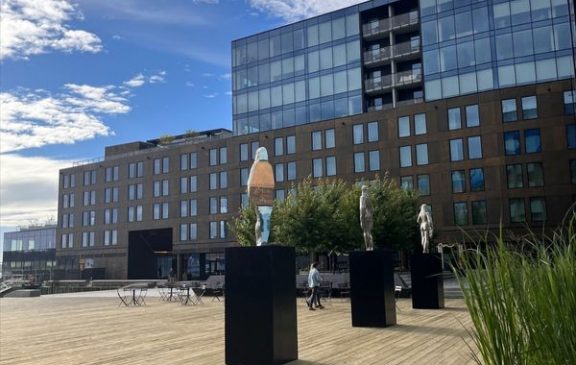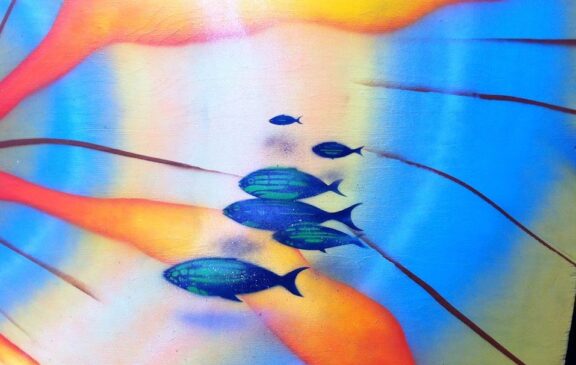
Sperry Design
Throughout the district, Sperry’s design work is reflected in the stories of Nova Scotia’s past and present – appearing through phrases, images and symbols etched on Muntz metal.
Detail
Throughout the district, Sperry’s design work is reflected in the stories of Nova Scotia’s past and present – appearing through phrases, images and symbols etched on Muntz metal.
Detail
Ned Kahn replicates the forms and forces of nature. An environmental artist and sculptor, his work captures the invisible aspect of nature and makes it visible.
Detail
Located in Rise Again square stands Greer’s ‘The Siren’s Calling’, four towering figures from Greek mythology, made from cast and polished stainless steel.
Detail
At the bottom of Prince Street sits ‘Sail’, an ethereal sculpture by Edoardo Tresoldi, using wire, mesh and lighting to create a 20-foot work of art reminiscent of a ghost ship floating on the water.
Detail
Best known for intricate sculptures made up of dot-like paint drops, Chris Dorosz deconstructs and reassembles images in a way that challenges our visual assumptions.
Detail
David Spriggs is known internationally for his unique large-scale 3D installations that use the technique of layering transparent images and panels.
Detail
The Light Chocks incorporate abstract Fresnel lenses, similar to those used in lighthouses throughout Nova Scotia, including the iconic Sambro Island Lighthouse.
Detail
Christian Toth is a multi-disciplinary Nova Scotia artist whose body of work includes painting, design, building, curating and photography.
Detail
“Water,” a dramatic photo by Thaddeus Holownia, iconic New Brunswick artist, teacher and Royal Society of Canada fellow has been embedded on a perforated façade bordering Lower Water Street.
Detail
Sperry Design is a local design firm that brings ideas and stories to life. Throughout the district, Sperry’s design work is reflected in the stories of Nova Scotia’s past and present – appearing through phrases, images and symbols etched on Muntz metal.
While walking through the district, pause and take a closer look at these panels. You’ll discover everything from ship manifests to stories of rum-running, lines of poetry and historical maps. The metal used on these panels was invented in 1842 and used in shipbuilding to stop the hulls of ships from rotting during long ocean voyages.

Ned Kahn replicates the forms and forces of nature. An environmental artist and sculptor, his work captures the invisible aspect of nature and makes it visible.
Ascending 40 feet above Rise Again and overlooking the Halifax waterfront, Tidal Beacon by Ned Kahn is a dramatic, interactive light display.
This towering art piece responds to the tides and weather, transforming itself with light, sound and motion.
As the tides change, light rises and shifts within the structure, culminating at high tide with a beaming beacon of light that shines into the sky and out over the harbour.

John Greer taught sculpture for 26 years at the Nova Scotia College of Art and Design in Halifax, Nova Scotia. His thinking and teaching shaped and influenced contemporary sculpture and three-dimensional art practice in Canada.
Located in Rise Again square stands Greer’s ‘The Siren’s Calling’, four towering figures from Greek mythology, made from cast and polished stainless steel. Each figure rests on a black granite monolith and faces a cardinal direction, their gazes calling up the dual role of the harbour as both a place of departure and a safe haven.
John Greer is the recipient of numerous awards and grants; in 2009 he received the prestigious Governor General’s Award in Visual Arts in recognition of his lifetime achievement and significant contribution to contemporary Canadian visual art.

At the bottom of Prince Street sits ‘Sail’, an ethereal sculpture by Edoardo Tresoldi, using wire, mesh and lighting to create a 20-foot work of art reminiscent of a ghost ship floating on the water. This piece invites the viewer to imagine that what may have disappeared may live again in a different time.
Born in Milan, Tresoldi moved to Rome after art school, working in sculpture, stage design and cinema.
Since 2013 he has produced installations in public spaces, archaeological sites, festivals and exhibitions around the world.

Best known for intricate sculptures made up of dot-like paint drops, Chris Dorosz deconstructs and reassembles images in a way that challenges our visual assumptions.
This Canadian artist earned his master’s degree at the Nova Scotia College of Art and Design. His work has been exhibited widely in Canada and throughout the United States, including a solo exhibition at the San Jose Institute of Contemporary Art in California.
Chris Dorosz has two works in the George Street Public Room. ‘Inhabitants’ are four sculptures that examine how our coastal terrain and weather are at play on our bodies. ‘Embarkment Steps’ ponders the effect of how two opposing forces, land and sea, meet and live in harmony.

David Spriggs is known internationally for his unique large-scale 3D installations that use the technique of layering transparent images and panels.
‘Zenith’, located in the George Street Public Room, references the strength of both the ocean and the people of Nova Scotia.
Worth a look close up, this piece, created from a number of panels working together, exists in both two and three dimensions. At night, it shines onto Lower Water Street evoking the movement and spray of the ocean.
David Spriggs is currently based in Vancouver, BC.

Our region’s most celebrated architect, Brian MacKay-Lyons, of MacKay-Lyons Sweetapple Architects, has established a global reputation through ‘Born of this Place’ design.
The Light Chocks incorporate abstract Fresnel lenses, similar to those used in lighthouses throughout Nova Scotia, including the iconic Sambro Island Lighthouse. Much like a lighthouse, they light up at night, welcoming and guiding visitors and old friends.
Brian MacKay-Lyons employs a deep understanding of local vernacular, modern, clean lines and honest materiality to impart a clear and pure sense of Nova Scotia

Christian Toth is a multi-disciplinary Nova Scotia artist whose body of work includes painting, design, building, curating and photography.
Toth has developed a series of murals throughout the parking garage beneath the district. These murals remind us of our proximity and connection to the ocean.

“Water” a dramatic photo by Thaddeus Holownia, iconic New Brunswick artist, teacher and Royal Society of Canada fellow has been embedded on a perforated facade bordering Lower Water Street.
After a forty-one-year teaching career in the Department of Fine Arts at Mount Allison University in Sackville, New Brunswick, Holownia recently retired and now spends his time at his studio in Jolicure, New Brunswick.